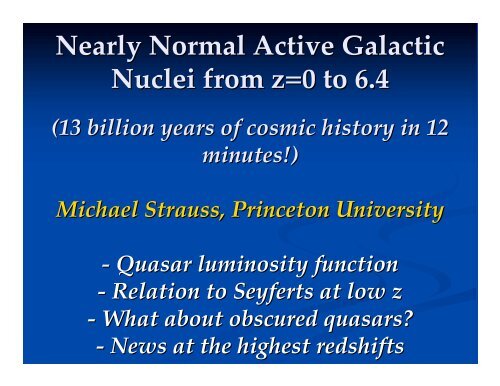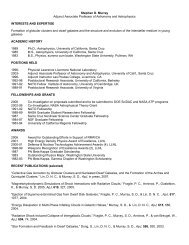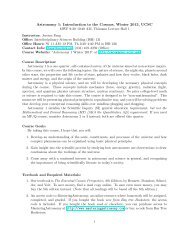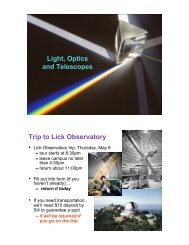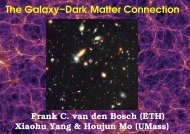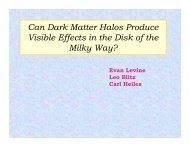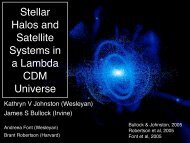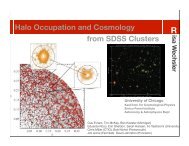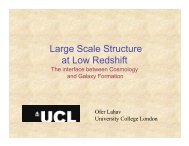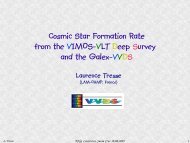Michael Strauss
Michael Strauss
Michael Strauss
Create successful ePaper yourself
Turn your PDF publications into a flip-book with our unique Google optimized e-Paper software.
Nearly Normal Active Galactic<br />
Nuclei from z=0 to 6.4<br />
(13 billion years of cosmic history in 12<br />
minutes!)<br />
<strong>Michael</strong> <strong>Strauss</strong>, Princeton University<br />
- Quasar luminosity function<br />
- Relation to Seyferts at low z<br />
- What about obscured quasars?<br />
- News at the highest redshifts
My collaborators on the work<br />
shown here:<br />
My former and current grad students: Xiaohui Fan, Lei Hao,<br />
Nadia Zakamska, Joe Hennawi<br />
Former Postdocs: Gordon Richards, Pat Hall<br />
Julian Krolik, Tim Heckman, Bob Becker, Richard White,<br />
Christy Tremonti, Guinevere Kauffmann.<br />
And the whole SDSS collaboration, especially:<br />
Jim Gunn, Jill Knapp, Robert Lupton, David Schlegel,<br />
Sebastian Jester, Don Schneider, Dan Vanden Berk, Zeljko<br />
Ivezic, and many others.
Using SDSS for AGN Studies<br />
n A color-selected sample of quasars,<br />
sensitive from z=0 to z>6. 90,000 quasars<br />
and counting.<br />
n A magnitude-limited sample of more than<br />
500,000 galaxies, from which Seyferts can<br />
be selected.<br />
n Superb morphologies, photometry,<br />
astrometry, and R=2000 photometrically<br />
calibrated spectroscopy, 3800-9200 Å.
SDSS Quasar Sample<br />
Courtesy Xiaohui Fan
The Luminosity Function from<br />
the full SDSS<br />
(here, a complete sample of<br />
15,000 quasars)<br />
n Can study luminous<br />
quasars over the full range<br />
of redshift with a single<br />
sample (note that we do not<br />
go to very low<br />
luminosities…)<br />
luminosities<br />
n Substantial (and<br />
quantifiable)<br />
incompleteness at z=2.7,<br />
3.5.<br />
Richards et al. 2005c
Systematic flattening of the<br />
LF above z~3
Comoving number<br />
density peaks<br />
between z=2 =2 and 3<br />
LF slope increases at<br />
z=3 =3 and above.
n 5645 quasars<br />
with g < 21.85<br />
selected from<br />
SDSS imaging,<br />
observed with<br />
2dF at AAT. UV<br />
excess sources,<br />
almost all with z<br />
< 2.5. Best-fit<br />
slope b is -1.45 at<br />
faint end.<br />
A crucial question: the shape and<br />
slope of the LF at the faint end… end<br />
Richards et al. 2005a<br />
MNRAS
The nature of low-luminosity<br />
quasars<br />
n As we push to lower luminosities still (at low<br />
redshift), redshift),<br />
emission from the host galaxy becomes<br />
an ever-larger fraction of the total luminosity.<br />
n Here we select both Type I and Type II Seyfert<br />
galaxies from the SDSS main galaxy sample.<br />
Lei Hao 2003, PhD Thesis; Hao et al. 2005ab in AJ
Host galaxies can contribute substantial light to the spectra,<br />
which needs to be subtracted. Lei Hao, PhD Thesis, 2003
Ratios of various emission lines allow us to distinguish active nuclei<br />
from star formation for Seyfert II galaxies (see also Kauffmann et al.)
Seyfert I galaxies are recognized by their broad permitted emission<br />
lines. The distribution of line widths is strongly bimodal.
The relative number of Type I and Type II galaxies<br />
is a function of luminosity
The active galaxy luminosity function fits nicely onto the higherredshift<br />
quasar luminosity function.
n Very few high-luminosity Type II quasars are known.<br />
Essentially all high-luminosity objects show broad<br />
lines.<br />
n If the unification model is correct, then Type II<br />
quasars must exist at high luminosity.<br />
Characteristics:<br />
n Characteristics:<br />
n Weak or absent non-thermal continuum<br />
n Strong narrow high-ionization emission lines<br />
n So we went to look for such objects in SDSS!<br />
(Nadia ( Nadia Zakamska, Zakamska,<br />
PhD Thesis, 2005)<br />
2005
Type II Quasar Candidates
How do we determine intrinsic<br />
luminosity?<br />
Look in mid-IR?<br />
Look in hard<br />
X-rays?<br />
Optically:<br />
Use [OIII] 5007<br />
We have carried out a<br />
comprehensive follow-up<br />
program:<br />
X-ray (XMM, Chandra)<br />
HST images<br />
Far-IR photometry,<br />
mid-IR spectra (Spitzer)<br />
Spectropolarimetry (MMT)<br />
Near-infrared spectroscopy<br />
(Gemini)
A spectacular result:<br />
20% polarization in<br />
one object! This is<br />
unambiguously an<br />
obscured source!<br />
(And we now have 11 more<br />
objects with spectropolarimetry,<br />
8 are strongly polarized).<br />
Zakamska et al. 2005<br />
Broad polarized Hb<br />
Schmidt, Smith et al 2004
• Multiband continuum<br />
imaging with HST resolves<br />
the scattering region in<br />
three cases.<br />
• In each of these, the<br />
scattering region is<br />
perpendicular to the<br />
direction of polarization, as<br />
expected.<br />
• The physical extent of the<br />
scattering region (many<br />
kpc) and the weakness of<br />
any accompanying Balmer<br />
emission rules out electron<br />
scattering: dust scattering<br />
seems to dominate.
• Very few objects<br />
are detected in soft<br />
X-rays in ROSAT,<br />
consistent with<br />
absorption by H<br />
gas.<br />
• Six objects have<br />
Chandra or XMM<br />
hard X-ray<br />
detections,<br />
consistent with<br />
implied<br />
luminosities, and<br />
with column<br />
densities of > few<br />
¥ 10 22 cm -2<br />
Ptak et al. 2005
A montage of HST images of SDSSSDSSselected obscured quasars<br />
(Zakamska et al.)
Optical<br />
3-8 mm<br />
How luminous are these<br />
systems? Spitzer<br />
observations<br />
10 44-46 erg/sec in<br />
Far-IR
These objects have IRAC colors<br />
consistent with, or perhaps redder<br />
than, IRAC-selected AGN…<br />
First IRS spectroscopy shows<br />
pure power-law: no spectral<br />
features! (where is 10mm Si?)
Conclusions<br />
ß SDSS is a tremendously powerful tool for studying the optical<br />
properties of AGN at z=0 to z=6.5.<br />
ß Luminous quasars peaked in comoving space density at z~2.5.<br />
Luminosity function slope change is qualitatively consistent<br />
with ‘cosmic downsizing’ picture.<br />
ß At low redshifts, AGN luminosity function can be pushed<br />
down to very low luminosities. Continuity with classical<br />
quasars is work in progress.<br />
ß Very luminous Type II quasars can be selected from the<br />
SDSS spectroscopic sample, and studied in detail.<br />
ß Ask me about the latest results on quasars at high (z~6)<br />
quasars…
19 quasars with z>5.7
Composite Spectrum at low and high<br />
redshift<br />
Quasar spectra at high redshift are completely normal!<br />
Fan et al. 2004


